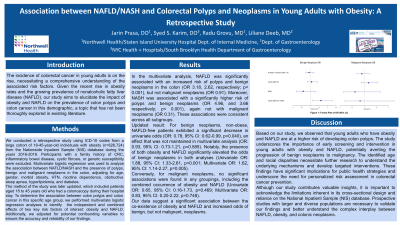Tuesday Poster Session
Category: Colorectal Cancer Prevention
P3171 - Association Between NAFLD/NASH and Colorectal Polyps and Neoplasms in Young Adults With Obesity: A Retrospective Study
Tuesday, October 24, 2023
10:30 AM - 4:00 PM PT
Location: Exhibit Hall

Has Audio

Jarin Prasa, DO
Staten Island University Hospital
Brooklyn, NY
Presenting Author(s)
Award: Presidential Poster Award
Jarin Prasa, DO1, Radu Grovu, MD2, Syed S. Karim, DO3, Liliane Deeb, MD2
1Staten Island University Hospital, Brooklyn, NY; 2Staten Island University Hospital, Staten Island, NY; 3NYC Health + Hospitals South Brooklyn Health, Glen Oaks, NY
Introduction: Obesity, nonalcoholic fatty liver disease (NAFLD) and nonalcoholic steatohepatitis (NASH) has been associated with an increased risk of colon polyps and colorectal cancer (CRC). However, whether these patients need to be screened earlier is not well established. Therefore, we aimed to investigate the association between NAFLD/NASH and the presence of colon polyps and CRC in the young obese population.
Methods: We conducted a retrospective study using ICD-10 codes from a large cohort of 18 to 45-year-old individuals with obesity (n=626,724) from the Nationwide Inpatient Sample (NIS) database during the years 2016-2018. Participants with a family history of CRC, inflammatory bowel disease, cystic fibrosis, or genetic susceptibility were excluded. Multivariate logistic regression was used to analyze the association between NAFLD/NASH and the presence of polyps, benign and malignant neoplasms in the colon, adjusting for age, gender, morbid obesity, HTN, nicotine dependence, obstructive sleep apnea, hyperlipidemia, and diabetes.
Results: After excluding 7,422 participants with the above exclusion criteria, the final dataset included 619,302 individuals. In the multivariate analysis, NAFLD was significantly associated with an increased risk of polyps and benign neoplasms in the colon (OR 3.18, 2.62, respectively; p< 0.001), but not malignant neoplasms (OR 0.91). Moreover, NASH was associated with a significantly higher risk of polyps and benign neoplasms (OR 4.96, and 3.66 respectively; p< 0.001), again not with malignant neoplasms (OR 0.31). These associations were consistent across all subgroups.
Discussion: The study found that young patients with obesity and NAFLD were at an increased risk of developing colon polyps, and the risk further increased for those with NASH. The odds for malignant neoplasms were found to be lower in these two populations, however we believe the increased presence of polyps alone is a risk for the further development of CRC. The underlying mechanisms may involve chronic inflammation, oxidative stress, and insulin resistance which promotes the development of growth factors and polyp occurrence. Furthermore, studies indicate that individuals who have pre-existing NAFLD and obesity may have a worse prognosis when diagnosed with CRC. Hence, it may be good practice to screen young patients with obesity and NAFLD/NASH for colon polyps and cancer before the recommended age of 45. Early detection and intervention can help prevent the progression of these conditions.
Disclosures:
Jarin Prasa, DO1, Radu Grovu, MD2, Syed S. Karim, DO3, Liliane Deeb, MD2. P3171 - Association Between NAFLD/NASH and Colorectal Polyps and Neoplasms in Young Adults With Obesity: A Retrospective Study, ACG 2023 Annual Scientific Meeting Abstracts. Vancouver, BC, Canada: American College of Gastroenterology.
Jarin Prasa, DO1, Radu Grovu, MD2, Syed S. Karim, DO3, Liliane Deeb, MD2
1Staten Island University Hospital, Brooklyn, NY; 2Staten Island University Hospital, Staten Island, NY; 3NYC Health + Hospitals South Brooklyn Health, Glen Oaks, NY
Introduction: Obesity, nonalcoholic fatty liver disease (NAFLD) and nonalcoholic steatohepatitis (NASH) has been associated with an increased risk of colon polyps and colorectal cancer (CRC). However, whether these patients need to be screened earlier is not well established. Therefore, we aimed to investigate the association between NAFLD/NASH and the presence of colon polyps and CRC in the young obese population.
Methods: We conducted a retrospective study using ICD-10 codes from a large cohort of 18 to 45-year-old individuals with obesity (n=626,724) from the Nationwide Inpatient Sample (NIS) database during the years 2016-2018. Participants with a family history of CRC, inflammatory bowel disease, cystic fibrosis, or genetic susceptibility were excluded. Multivariate logistic regression was used to analyze the association between NAFLD/NASH and the presence of polyps, benign and malignant neoplasms in the colon, adjusting for age, gender, morbid obesity, HTN, nicotine dependence, obstructive sleep apnea, hyperlipidemia, and diabetes.
Results: After excluding 7,422 participants with the above exclusion criteria, the final dataset included 619,302 individuals. In the multivariate analysis, NAFLD was significantly associated with an increased risk of polyps and benign neoplasms in the colon (OR 3.18, 2.62, respectively; p< 0.001), but not malignant neoplasms (OR 0.91). Moreover, NASH was associated with a significantly higher risk of polyps and benign neoplasms (OR 4.96, and 3.66 respectively; p< 0.001), again not with malignant neoplasms (OR 0.31). These associations were consistent across all subgroups.
Discussion: The study found that young patients with obesity and NAFLD were at an increased risk of developing colon polyps, and the risk further increased for those with NASH. The odds for malignant neoplasms were found to be lower in these two populations, however we believe the increased presence of polyps alone is a risk for the further development of CRC. The underlying mechanisms may involve chronic inflammation, oxidative stress, and insulin resistance which promotes the development of growth factors and polyp occurrence. Furthermore, studies indicate that individuals who have pre-existing NAFLD and obesity may have a worse prognosis when diagnosed with CRC. Hence, it may be good practice to screen young patients with obesity and NAFLD/NASH for colon polyps and cancer before the recommended age of 45. Early detection and intervention can help prevent the progression of these conditions.
Disclosures:
Jarin Prasa indicated no relevant financial relationships.
Radu Grovu indicated no relevant financial relationships.
Syed Karim indicated no relevant financial relationships.
Liliane Deeb indicated no relevant financial relationships.
Jarin Prasa, DO1, Radu Grovu, MD2, Syed S. Karim, DO3, Liliane Deeb, MD2. P3171 - Association Between NAFLD/NASH and Colorectal Polyps and Neoplasms in Young Adults With Obesity: A Retrospective Study, ACG 2023 Annual Scientific Meeting Abstracts. Vancouver, BC, Canada: American College of Gastroenterology.

